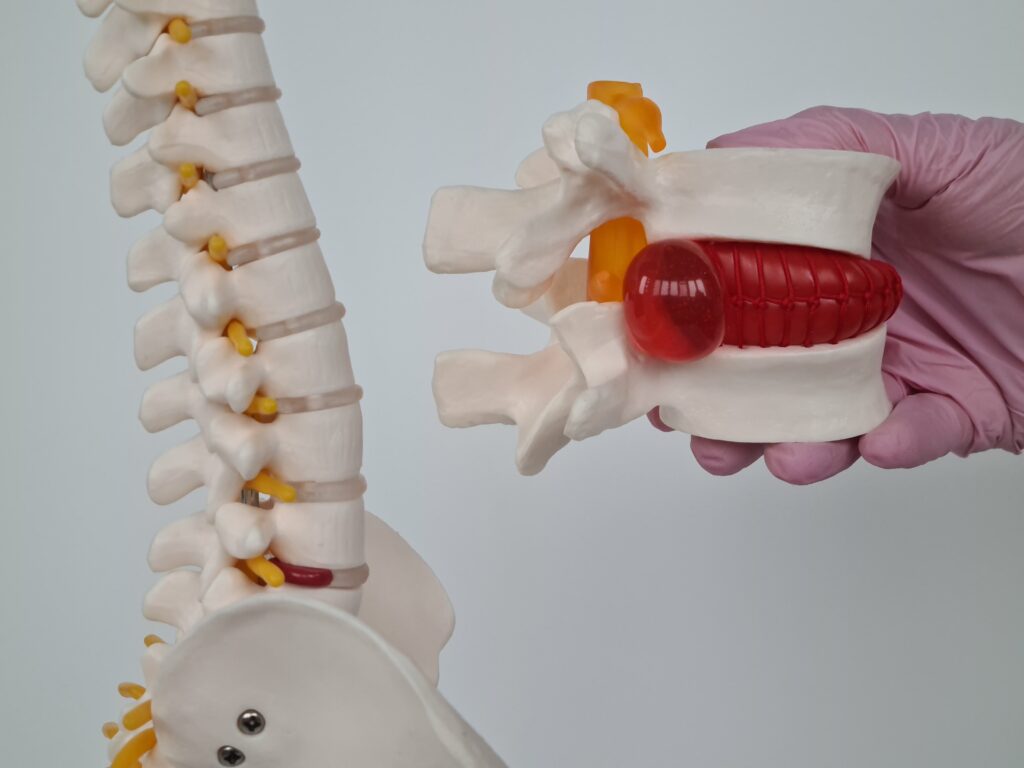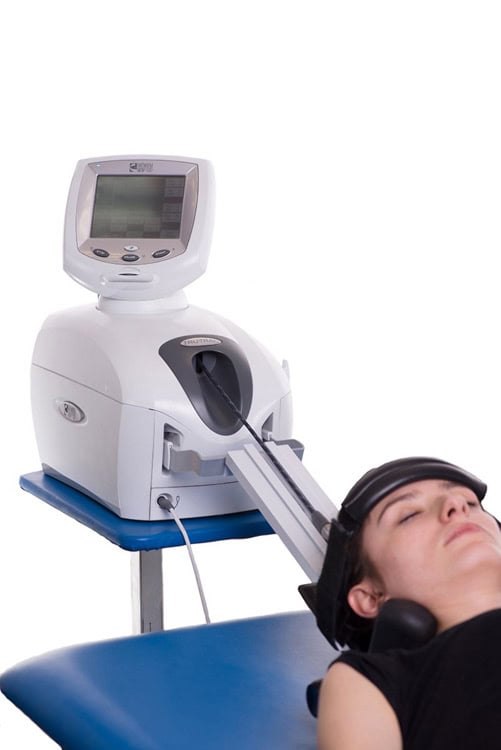What does discopathy mean
Discopathy is a pathological (disease) condition of the intervertebral disc. The term itself is very general. Some degree of discopathy is possible in almost every adult, often without any symptoms.

Discopathy is a pathological (disease) condition of the intervertebral disc. The term itself is very general. Some degree of discopathy is possible in almost every adult, often without any symptoms.
Problem zaczyna być istotny, gdy pojawiają się tzw. ubytki czuciowe:
lub ubytki ruchowe:

All types of damage mentioned above may occur suddenly (as a result of trauma, traffic accident) or may take years to develop as a result of regular, cumulative overloads of the spine ( smartphone user’s neck).
Nowadays, children are especially at risk of developing cervical discopathy due to long-term use of devices such as tablets and smartphones with their heads positioned in the so-called protraction.
The best test to illustrate the condition of the discs is magnetic resonance imaging. Good quality MRI allows you to determine the extent of disc damage and possible conflict with neural structures (nerve pressure). Magnetic resonance imaging combined with the patient’s examination allows us to determine the possibilities of non-surgical treatment.

In the absence of obvious, significant sequestration (detachment of part of the disc), non-surgical treatment of the damaged disc can be initiated. The plasticity of the nervous system is so high that properly selected therapeutic parameters guarantee the effectiveness of treatment even in the case of large disc herniations.
A damaged disc causes a mechanical disorder – it presses on the nerve. The diseased disc is significantly reduced and its gel-like contents “flow” beyond the vertebral structures, causing compression of the spinal nerve. Non-surgical treatment of discopathy involves creating a mechanical decompression of the disc of a pulsating nature, repeated several dozen times during one therapeutic session. Thanks to this, the disc “expands” and the space between the vertebrae increases. This causes the nerve to stop being compressed. Axial pulsed extraction is used to achieve this effect.

The use of pulsed axial traction requires the preparation of peri-spinal tissues. For this reason, before the lift, the patient undergoes preparatory manual therapy (relaxation of muscles and fascia). The entire treatment (manual therapy + pulsed axial traction) lasts approximately 45 minutes. Depending on the extent of disc damage, 10 to 20 treatments are performed in a series, 2-3 times a week. At the end of the series, the patient receives a recommendation/exercises to perform at home to prevent the recurrence of the symptoms.
During the visit, preparatory manual therapy and pulsed axial traction will be performed.
In the online booking panel, select the service: terapia osteopatyczna/manualna
Once you have made your reservation, be sure to check your email to ensure your reservation has been approved.
I consent to the processing of personal data in accordance with the Personal Data Protection Act in connection with sending an inquiry via the reservation form. Providing data is voluntary, but necessary to process the inquiry. I have been informed that I have the right to access my data, the possibility of correcting it, and requesting the cessation of its processing. The administrator of personal data is Rehios Szymon Miazga ul. Rakowiecka 32A U-103 02-532 Warszawa.

Dyskopatia jest patologicznym ( chorobowym) stanem krążka międzykręgowego ( inaczej dysku). Samo określenie jest bardzo ogólne. Pewien stopień dyskopatii jest możliwy niemalże u każdego dorosłego, często nie dając żadnych dolegliwości.
Problem zaczyna być istotny, gdy pojawiają się tzw. ubytki czuciowe:
lub ubytki ruchowe:

Wszystkie rodzaje wymienionych uszkodzeń mogą powstać nagle ( np. na skutek urazu, wypadku komunikacyjnego) lub tworzyć się latami jako skutek regularnych sumujących się przeciążeń kręgosłupa ( np. szyja smartfonowca).
W dzisiejszych czasach szczególnie dzieci narażone są na rozwój dyskopatii szyjnej w związku z długotrwałym korzystaniem z urządzeń typu tablet, smartfon z głową ustawioną w tzw. protrakcji.
Najlepszym badaniem obrazującym stan dysków jest rezonans magnetyczny. Dobrej jakości rezonans pozwala określić rozległość uszkodzenia dysku oraz ewentualny konflikt ze strukturami nerwowymi ( ucisk na nerw). Rezonans magnetyczny w połączeniu z przeprowadzonym badaniem Pacjenta pozwala określić możliwości nieoperacyjnego leczenia.

W przypadku braku ewidentnych, znacznych sekwestracji ( oderwania części dysku) można rozpocząć nieoperacyjne leczenie uszkodzonego dysku. Plastyczność układu nerwowego jest tak wysoka, że prawidłowo dobrane parametry terapeutyczne, gwarantują skuteczność leczenia nawet przy dużych przepuklinach krążka.
Uszkodzony dysk powoduje zaburzenie o charakterze mechanicznym – uciska nerw. Zmieniony chorobowo dysk ulega znacznemu obniżeniu a jego żelowata zawartość “wypływa” poza struktury kręgowe powodując ucisk nerwu rdzeniowego.
Nieoperacyjne leczenie dyskopatii polega na stworzeniu mechanicznego odbarczenia dysku o charakterze pulsacyjnym, powtarzanym kilkadziesiąt razy podczas jednej sesji terapeutycznej. Dzięki temu dysk się “rozpręża” , a przestrzeń pomiędzy kręgami zwiększa. To powoduje, że nerw przestaje być uciskany. Do uzyskania tego efektu stosuje się wyciąg osiowy pulsacyjny.

Zastosowanie wyciągu osiowego pulsacyjnego wymaga przygotowania tkanek okołokręgosłupowych . Z tego powodu przed wyciągiem Pacjent poddawany jest przygotowawczej terapii manualnej ( rozluźnienie mięśni i powięzi).
Całość zabiegu ( terapia manualna + pulsacyjny wyciąg osiowy ) trwa ok. 45 min.
W zależności od rozległości uszkodzenia dysku stosuje się od 10 do 20 zabiegów w serii, z częstotliwością 2-3 razy w tygodniu.
Na koniec serii Pacjent otrzymuje zalecenie/ćwiczenia do wykonywania w warunkach domowych, tak by zapobiec nawrotowi dolegliwości.
Podczas wizyty wykona zostanie terapia manualna przygotowawcza oraz pulsacyjny wyciąg osiowy.
W panelu rezerwacja on-line wybierz usługę: terapia osteopatyczna/manualna
Wyrażam zgodę na przetwarzanie danych osobowych zgodnie z ustawą o ochronie danych osobowych w związku z wysłaniem zapytania przez formularz rezerwacyjny. Podanie danych jest dobrowolne, ale niezbędne do przetworzenia zapytania. Zostałem poinformowany, że przysługuje mi prawo dostępu do swoich danych, możliwości ich poprawiania, żądania zaprzestania ich przetwarzania. Administratorem danych osobowych jest Rehios Szymon Miazga ul. Rakowiecka 32A u 103 02-532 Warszawa.
